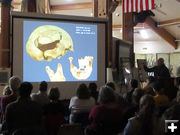

Violent death
A male, approximately 25-27 years old, was one of six victims killed 1,000 years ago near what is now Pinedale. (Photographic representation of injuries to skull)
|
|
Update on the Pinedale Bones
by Dawn Ballou, Pinedale Online!
October 23, 2019
On Tuesday, October 15th the Upper Green River Basin Chapter of the Archaeological Society had a special presentation at the Museum of the Mountain Man by anthropologist Rick Weathermon from the University of Wyoming. Weathermon is a Senior Research Scientist at the Department of Anthropology at the University of Wyoming. He gave a presentation entitled, "Violent Confrontations in Western Wyoming during the Late Prehistoric Period." As part of his talk, Weathermon gave an update on the Pinedale Bones.
What are the "Pinedale Bones?" In May, 2007, construction workers digging a septic system on private property just west of Pinedale found some human skulls. Authorities were immediately called. It was determined that the bones were not recent, and authorities then contacted archaeologists with the Bureau of Land Management in the nearby Pinedale office for consultation at the site. By evening, enough bones had been recovered indicating at least six individuals, and possibly seven, were present. During construction, all of the bones found had been moved, probably during the backfill operation by a trackhoe, so no remains were found articulated or in place where they were originally deposited.
Here are some of the latest updates from the October 15 presentation:
The bones were those of six individuals, three adults and three children. There was one male and two adult females and three children ranging in age from 6 years old to toddler. All were radiocarbon dated to approximately 1,000 years old. The ethnicity is Native American, but tribal affiliation has not been determined. All died violent deaths. The skulls of the adults and one of the children showed blunt force trauma from a large round object. The younger two children did not have damaged skulls, but their ribs were caved in suggesting they had possibly been stomped on. None of the bones showed any signs of defensive wounds.
Male, 25-28 years old. No nutritional stress. 2 blows to head, likely fatal. No defensive wounds. Third blow upward broke his chin in half and busted his entire face.
Female, 32-37 years old. Bones indicate she had more than one child. Crushed area on back of her skull from a single blow. No defensive wounds. She had nice teeth.
Female, 19-22 years old. One strike to back of her skull, also signs of a second blow to skull. She had signs of an old break on her arm that was healed. No defensive wounds.
3 other young individuals:
Male child, 4-1/2 to 5-1/2 years old. Skull hit with some weapon, crushed, canít put skull back together
Possible male child: 1-3 years old. Ribs caved in, possibly stomped on rather than hit.
Possible female child: 1.5-2.5 years old. Ribs caved in, possibly stomped on rather than hit.
DNA was attempted on the bones not long after they were found in the hopes of trying to determine if the people were related to each other, but results were inconclusive. Technological advances in DNA analysis may offer better information if the bones are reanalyzed. Other analytical techniques could offer information about diet and geographical location on these individuals.
Wounds suggest people were executed rather than killed in battle. All the adults were hit on the back of the head suggesting they may have been incapacitated at the time of their deaths and couldnít defend themselves.
Another mystery is that it appears the bones of the people who died at the site were buried shortly after death. There was no scattering of the bones by scavengers as would happen if they were left to lay on the ground after killed. It is unknown who may have buried them. Other burials of people found of that time period in the area are typically bodies placed on scaffolds and left to decompose and bones are later gathered and then reburied as bundles in other final resting place locations such as in crevices.
Weathermon said in his presentation that violent confrontations between individuals and groups are apparent during the early Late Prehistoric period in the western Wyoming area. The Late Prehistoric Period is sometimes also called the Precontact Period, indicating the time before contact between Native people and Europeans.
Multiple individuals documented in western Wyoming from this time period exhibit traumatic injuries, with a lack of defensive wounds on some suggesting capture and subsequent execution. Importantly, these individuals share a distinct cluster of skeletal characteristics.
Similar conflicts are also evidenced during this same time among established horticultural groups in the American southwest along the southern and eastern edges of the Great Basin. It is speculated that perhaps extended periods of drought during the Medieval Warm Period placed stresses on human groups in and around these areas leading to population shifts in search of food. Changes in projectile point styles, ceramic technologies, and rock art in this same timeframe suggest some groups were expanding into Wyoming, potentially displacing or replacing earlier inhabitants. The Pinedale Bones add significant information to the interpretations of this violent period in Wyoming.
For more background see Human Skeletons Found Near Pinedale (May, 2007), Ancient Human Remains Found, and An Update on Bones Found Near Pinedale (July, 2007).
For more information on the Upper Green River Basin Chapter of the Wyoming Archaeological Society, visit www.sublette.com/was.
|
